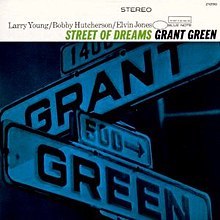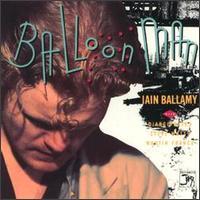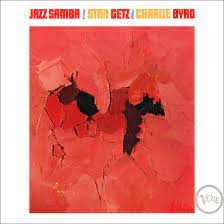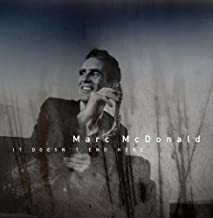
The Quarantined Jazz Voyager
This week another great album is being featured for us to listen to titled Street of Dreams recorded at Van Gelder Studio in Englewood Cliffs, New Jersey on November 16, 1964 by jazz guitarist Grant Green. The album was produced by Alfred Lion, however, wasn’t released until August 1967 on the Blue Note label. The photograph used on the album cover features street signs that are at an actual street corner in the North Beach neighborhood of San Francisco, California.
The conversation between these four giants of jazz is comfortable and easy. They play off one another, adding to the strength of the album. Consisting of a mere four songs, one can hear the short story they create.
The album includes Billy May’s Somewhere in the Night, which was the theme of the television program Naked City, and Lazy Afternoon, from the 1954 musical The Golden Apple. On the whole, this is an enjoyable thirty-three minutes of mid~tempo jazz. While you’re listening, think about protecting your community as we continue to experience the ravages of this pandemic… which, by the way, although it may feel like it, hasn’t gone away yet people!
Track List | 33:34- I Wish You Love (Léo Chauliac, Charles Trenet) ~8:46
- Lazy Afternoon (John La Latouche, Jerome Moross) ~ 7:44
- Street of Dreams (Victor Young, Sam M. Lewis) ~ 9:03
- Somewhere in the Night (Billy May, Milt Raskin) ~ 8:01
- Grant Green ~ guitar
- Bobby Hutcherson ~ vibes
- Larry Young ~ organ
- Elvin Jones ~ drums
More Posts: adventure,album,club,genius,guitar,jazz,museum,music,preserving,restaurant,travel

Daily Dose Of Jazz…
Iain Ballamy was born Guildford, England on February 20, 1964. Taking piano lessons from age of 6 to 14, he received further education at George Abbot School from 1975 to 1980. He went on to study Musical Instrument Technology from 1980 to 1982 at Merton College.
Discovering the saxophone in 1978 with three lessons, his first professional gig was in 1980, playing Ronnie Scotts as the Iain Ballamy Quartet at age 20. He was a founding member of Loose Tubes in 1984. His first recording was with Billy Jenkinsthe following year, and his first solo album, Balloon Man, was released in 1988.
During his career, his performances and recording sessions reads like a who’s who list, including but not limited to Gil Evans, Hermeto Pascoal, Carla Bley, Dewey Redman, George Coleman, London Sinfonietta, Françios Jeanneau, Randy Weston, Clare Martin, Charlie Watts Orchestra, Jeremy Stacey, Jane Chapman, Bryan Ferry, Everything But The Girl, Ian Shaw, Slim Gaillard, Ronnie Scott, Gordon Beck, and one of his closest musical collaborators, Django Bates.
In 1999, Ballamy founded the record label Feral Records, in partnership with graphic artist and filmmaker Dave McKean. He composed the musical score for the movie MirrorMask and the score for the film Luna, both directed by McKean.
Bellamy is currently a visiting professor at the Royal Academy of Music, Birmingham Conservatoire, Trinity College of Music, and the Royal Welsh College of Music & Drama. Modern saxophonist and composer Iain Ballamy continues to explore jazz.
More Posts: bandleader,composer,educator,history,instrumental,jazz,music,saxophone

The Quarantined Jazz Voyager
The virus is still raging across America and now has a new host… the children. I have personally known a half dozen friends who have contracted Covid from children or grandchildren who are back in school and bring it home. Be vigilant my people and stay safe and healthy.
This week I am putting on the turntable the bossa nova/jazz album titled Jazz Samba. It is an album by Stan Getz and Charlie Byrd released by Verve Records in 1962. It was recorded on February 13, 1962 in Pierce Hall, All Souls Unitarian Church, Washington, D.C. and released the following April. It ws produced by Creed Taylor.
The idea for the album came about while the Charlie Byrd Trio was on a State Department goodwill tour in Brazil, drummer Buddy Deppenschmidt spent his free time with local musicians, teaching them American jazz and learning bossa nova from them. It was his idea to record an album combining jazz and bossa nova with Stan Getz.
Jazz Samba signaled the beginning of the bossa nova craze in America. Stan Getz was the featured soloist and the tracks were arranged by Charlie Byrd. It was recorded live in less than three hours and started a bossa nova craze both nationally and internationally.
It is the only jazz album to reach number one on both the jazz and pop Billboard charts and remained high on the charts for 70 weeks. Desafinado, the hit single from the album, was inducted into the Grammy Hall of Fame in 2000 and the album was inducted into the Grammy Hall of Fame in 2010.
Stan Getz won the Grammy Award for Best Jazz Performance of 1963 for Desafinado, and Robert Dimery included Jazz Samba in his book 1001 Albums You Must Hear Before You Die. The painting on the cover is by Olga Albizu.
Tracks | 33:12
Side One
- Desafinado (Antônio Carlos Jobim, Newton Mendonça) ~ 5:51
- Samba Dees Days (Charlie Byrd) ~ 3:34
- O Pato (Jayme Silva, Neuza Teixeira) ~ 2:31
- Samba Triste (Baden Powell, Billy Blanco) ~ 4:47
Side Two
- Samba de Uma Nota Só (Antônio Carlos Jobim, Newton Mendonça) ~ 6:11
- É Luxo Só (Ary Barroso) ~ 3:40
- Bahia (aka ‘Baia’) (Ary Barroso) ~ 6:38
- Stan Getz – tenor saxophone
- Charlie Byrd – guitar
- Gene Byrd – guitar, bass
- Keter Betts – double bass
- Buddy Deppenschmidt – drums, percussion
- Bill Reichenbach Sr. – drums, percussion
More Posts: adventure,album,club,genius,guitar,jazz,museum,music,preserving,restaurant,saxophone,travel

The Quarantined Jazz Voyager
The masks the President promised are out however, he has given all the manufacturers an opportunity to participate. You only get two or three N95’s depending on where you get them. So if your Amazon order is slow to come stop by your local pharmacy and pick up yours. Continue social distancing and remain safe.
This week sliding off the shelves in alto saxophonist Jackie McLean and his 1963 album Destination… Out! The album was recorded on September 20, 1963, produced by Alfred Lion and released in November of the following year on the Blue Note label. It is the second McLean album to feature Bobby Hutcherson and Grachan Moncur III.
He’s 31 years of age and primed torecord an album for the ages. Hard bop aside he ventured into free jazz on this one to explore new sounds and improvisation never heard before. Four tunes make up this release, three by Moncur and one by the leader, who recognized the former’s penchant for composition.
Growth mandates that we expand our personal listening repertoire, that we stray from our comfort zone, and explore the options jazz offers. Needless to say McLean has put together a stellar band of musicians who engage us with the conversation they fluidly and freely have along its journey.
Track Listing | 34:57
- Love and Hate (Grachan Moncur III) ~ 8:25
- Esoteric (Moncur) ~ 9:02
- Kahlil the Prophet (Jackie McLean) ~ 10:23
- Riff Raff (Moncur) ~ 7:07
- Jackie McLean ~ alto saxophone
- Grachan Moncur III ~ trombone
- Bobby Hutcherson ~ vibes
- Larry Ridley ~ bass
- Roy Haynes ~ drums
More Posts: adventure,album,club,genius,jazz,museum,music,preserving,restaurant,saxophone,travel

Daily Dose Of Jazz…
Marc McDonald was born in London, England on February 8, 1961 and lived there for six years before his parents moved to Princeton, New Jersey, where he grew up. Since the 1980s he has led groups in the New York City metropolitan areas as well as Honolulu, London and Athens. Releasing his debut CD as a leader, It Doesn’t End Here, it features his own compositions and the inventive arrangements of standards, drawing from mainstream jazz, Brazilian, and New Orleans R&B influences.
He has been equally active as a sideman and has been a member of award-winning composer Jamie Begian’s big band since 1998, appearing as a featured soloist on the band’s CD Trance.
In 1990, McDonald was among ten jazz composers invited to the ASCAP/Louis Armstrong Jazz Composers Workshop at New York’s Lincoln Center. Always the student, he attended the BMI Jazz Composers Workshop in New York for several years. Between 1991 and 1996 he was invited to premiere works for jazz chamber ensemble, solo saxophone, and saxophone quartet.
As an educator he has held a position for five years as a member of the artist faculty at a private music school in Princeton, and is currently in private teaching practice. Saxophonist and composer Marc McDonald continues to explore the world of jazz.
More Posts: bandleader,composer,history,instrumental,jazz,music,saxophone



